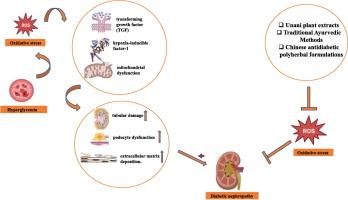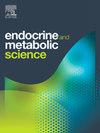Diabetic nephropathy: Pathophysiology and potential therapeutic role of plant extracts
Q3 Medicine
引用次数: 0
Abstract
Objective
This review aims to explore the molecular mechanisms underlying diabetic nephropathy (DN), with a particular focus on the role of oxidative stress. Additionally, it evaluates the therapeutic potential of plant-based extracts rich in bioactive compounds for the management of diabetes and its associated renal complications.
Results
Oxidative stress is identified as a key contributor to DN pathogenesis. Several major pathways are involved, including hypoxia-inducible factor-1 (HIF-1), transforming growth factor-beta (TGF-β), mitochondrial dysfunction, renin-angiotensin-aldosterone system (RAAS) activation, and endothelial nitric oxide synthase (eNOS) uncoupling. These mechanisms collectively lead to podocyte injury, tubular damage, extracellular matrix accumulation, disrupted renal hemodynamics, and glomerular hyperfiltration. Plant-derived compounds have shown potential in modulating these pathways, thereby offering renal protective effects.
Conclusion
Plant-based remedies enriched with bioactive compounds represent promising adjunct therapies for managing diabetes and its renal complications. Their integration into conventional treatment regimens may provide a holistic approach to glycemic control and reduction of oxidative stress-induced kidney damage. This review underscores the importance of multifaceted therapeutic strategies targeting both metabolic dysregulation and oxidative stress to effectively prevent and manage diabetic nephropathy.

糖尿病肾病:植物提取物的病理生理和潜在治疗作用
目的探讨糖尿病肾病(DN)的分子机制,特别是氧化应激的作用。此外,它还评估了富含生物活性化合物的植物提取物对糖尿病及其相关肾脏并发症的治疗潜力。结果氧化应激是DN发病的关键因素。其中包括缺氧诱导因子-1 (HIF-1)、转化生长因子-β (TGF-β)、线粒体功能障碍、肾素-血管紧张素-醛固酮系统(RAAS)激活和内皮型一氧化氮合酶(eNOS)解偶联。这些机制共同导致足细胞损伤、小管损伤、细胞外基质积累、肾血流动力学破坏和肾小球高滤过。植物源性化合物已显示出调节这些途径的潜力,从而提供肾脏保护作用。结论富含生物活性化合物的植物性药物是治疗糖尿病及其肾脏并发症的有希望的辅助疗法。将它们整合到常规治疗方案中,可能为血糖控制和减少氧化应激引起的肾损伤提供一种全面的方法。这篇综述强调了针对代谢失调和氧化应激的多方面治疗策略对有效预防和管理糖尿病肾病的重要性。
本文章由计算机程序翻译,如有差异,请以英文原文为准。
求助全文
约1分钟内获得全文
求助全文
来源期刊

Endocrine and Metabolic Science
Medicine-Endocrinology, Diabetes and Metabolism
CiteScore
2.80
自引率
0.00%
发文量
4
审稿时长
84 days
 求助内容:
求助内容: 应助结果提醒方式:
应助结果提醒方式:


